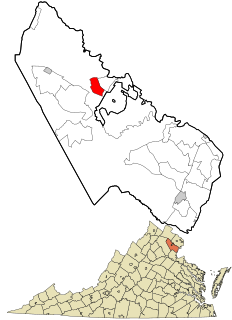
Bull Run is a census-designated place (CDP) in Prince William County, Virginia. The population was 14,983 at the 2010 census.
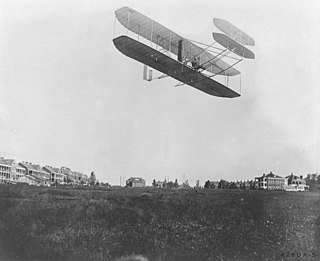
Fort Myer is the previous name used for a U.S. Army post next to Arlington National Cemetery in Arlington County, Virginia, and across the Potomac River from Washington, D.C. Founded during the American Civil War as Fort Cass and Fort Whipple, the post merged in 2005 with the neighboring Marine Corps installation, Henderson Hall, and is today named Joint Base Myer–Henderson Hall.

Johnson's Island is a 300-acre (120 ha) island in Sandusky Bay, located on the coast of Lake Erie, 3 miles (4.8 km) from the city of Sandusky, Ohio. It was the site of a prisoner-of-war camp for Confederate officers captured during the American Civil War. Initially, Johnson's Island was the only Union prison exclusively for Confederate officers but eventually held privates, political prisoners, persons sentenced to court martial and spies. Civilians who were arrested as guerrillas, or bushwhackers, were also imprisoned on the island. During its three years of operation, more than 15,000 men were incarcerated there.

Arlington House, The Robert E. Lee Memorial, formerly named the Custis-Lee Mansion, is a Greek revival style mansion located in Arlington, Virginia, United States that was once the home of Confederate Army General Robert E. Lee. It overlooks the Potomac River and the National Mall in Washington, D.C. During the American Civil War, the grounds of the mansion were selected as the site of Arlington National Cemetery, in part to ensure that Lee would never again be able to return to his home. The United States has since designated the mansion as a National Memorial. Although the United States Department of the Army controls Arlington National Cemetery, the National Park Service, a component of the United States Department of the Interior, administers Arlington House.
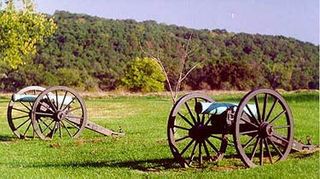
Wilson's Creek National Battlefield, located near Republic, Missouri, preserves the site of the Battle of Wilson's Creek. Fought on August 10, 1861, the battle was the first major American Civil War engagement west of the Mississippi River. In the battle, a Confederate army commanded by Benjamin McCulloch and Sterling Price defeated a smaller Union army commanded by Nathaniel Lyon. However, the Confederates were unable to hold much of Missouri, and a Confederate defeat at the Battle of Pea Ridge effectively solidified Union control of the state. Major features include a five-mile automobile tour loop, the restored 1852 Ray House, and "Bloody Hill," the site of the final stage of the battle. The site is located near Republic in southwestern Missouri just southwest of the city of Springfield. It has been a unit of the National Park Service since 1960, and was listed on the National Register of Historic Places in 1966.

Manassas National Battlefield Park is a unit of the National Park Service located in Prince William County, Virginia, north of Manassas that preserves the site of two major American Civil War battles: the First Battle of Bull Run, also called the First Battle of Manassas, and the Second Battle of Bull Run or Second Battle of Manassas. It was also where Confederate General Thomas J. Jackson acquired his nickname "Stonewall". The park was established in 1936 and listed on the National Register of Historic Places on October 15, 1966.

This is intended to be a complete list of the properties and districts on the National Register of Historic Places in Fairfield County, Connecticut, United States. The locations of National Register properties and districts for which the latitude and longitude coordinates are included below may be seen in an online map.

The McLean House near Appomattox, Virginia is within the Appomattox Court House National Historical Park. The house was owned by Wilmer McLean and his wife Virginia near the end of the American Civil War. It served as the location of the surrender conference for the Confederate army of General Robert E. Lee on April 9, 1865, after a nearby battle.
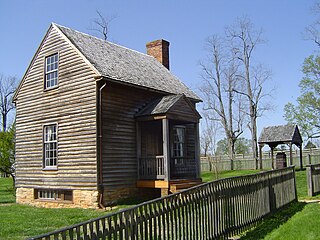
The Jones Law Office, also known as the Lorenzo D. Kelly House, is a structure within the Appomattox Court House National Historical Park. In the nineteenth century the structure was owned by Kelly and used as a single-family house. The original law office was also used as a dwelling by John Robinson for his large family in the nineteenth century after Kelly.

The Bocock–Isbell House is a structure within the Appomattox Court House National Historical Park. It was registered in the National Park Service's database of Official Structures on June 26, 1989.
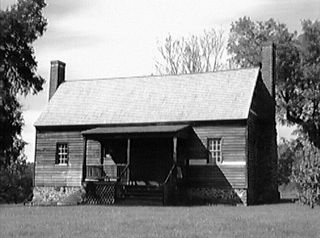
The Mariah Wright house is a structure within the Appomattox Court House National Historical Park. It was registered in the National Park Service's database of Official Structures on June 26, 1989.

The Sweeney Prizery is a structure within the Appomattox Court House National Historical Park. It was registered in the National Park Service's database of Official Structures on June 26, 1989.
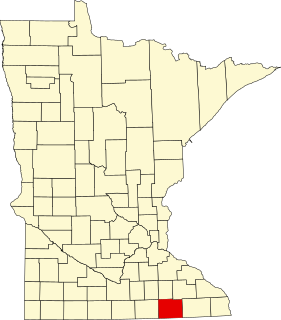
This is a list of the National Register of Historic Places listings in Mower County, Minnesota. It is intended to be a complete list of the properties and districts on the National Register of Historic Places in Mower County, Minnesota, United States. The locations of National Register properties and districts for which the latitude and longitude coordinates are included below, may be seen in an online map.

William Crawford Smith was an American architect who served in the Confederate States Army during the American Civil War and in the United States Army during the Philippine–American War. He designed many buildings in Nashville, Tennessee, including Kirkland Hall, the first building on the campus of Vanderbilt University, and the Parthenon in Centennial Park.

The Bray-Barron House is a historic house in Eufaula, Alabama, U.S.. It was built prior to 1850 for Nathan Bray, who went on to serve in the Confederate States Army during the American Civil War of 1861-1865 alongside his three brothers. The house remained in the family until 1963. It was purchased by N. G. Barron and his wife Ruby Hutton Barron in 1965. It has been listed on the National Register of Historic Places since May 27, 1971.

ElmwoodPlantation is a former plantation and a historic mansion, located in Rutherford County near Murfreesboro, Tennessee. It was built in the 1840s for Thomas Hord, a lawyer who owned slaves. It was once one of the largest plantation complexes in Middle Tennessee. The mansion was designed in the Classical Revival architectural style. During the Battle of Murfreesboro in 1862 to 1863, the Elmwood mansion was used as a hospital by the Union Army.

The Absalom Lowe Landis House, also known as Beech Hall, is a historic house in Normandy, Tennessee, U.S..

The Charles Ready House, also known as The Corners, is a historic house in Readyville, Tennessee, United States. It is located in Cannon County, on the border of Rutherford County.




















